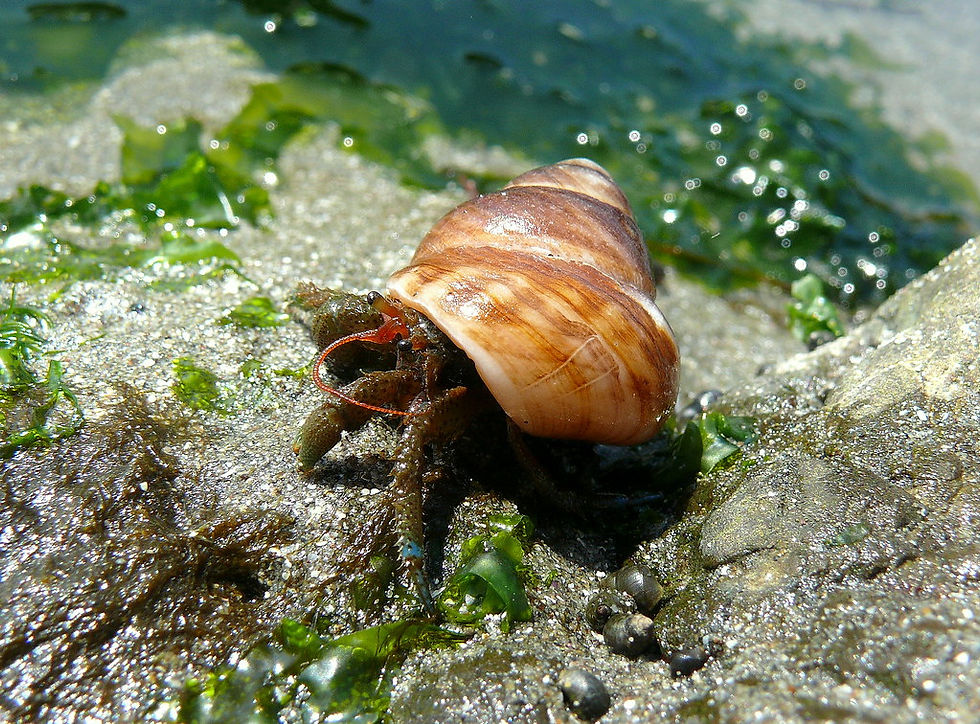How To Best Care For Your Hermit Crab
- Mentone Aquarium
- Aug 6, 2021
- 3 min read
Updated: Aug 18, 2021
FOOD
In their natural habitat a hermit crabs diet consists of leaf litter, fruits, vegetation and decaying wood (with the exception of conifers such as pine and cedar). In captivity it is recommended that they be fed a good quality commercial food along with treats such as coconut, romaine lettuce, apple, white bread, plain popcorn (or with sea salt). Oyster shell, egg shell, or cuttlebone is recommended for calcium. Uneaten food should be removed daily to avoid spoilage.
WATER
It is important for your hermit crab to be able to bathe in salt water so have some available at all times. Fresh water should also always be available for drinking. Use a non-metallic shallow dish with a sponge placed in the centre to prevent drowning. The water provided must be the same quality that is used for tropical fish. Hard water with iron is not desirable.
HOUSING
Glass or plastic tanks can be used to house hermit crabs. A 40 litre or more tank is a good choice (the larger the cage the better). Hermit crabs are excellent climbers so you must ensure the tank is fully enclosed (this includes the lid!). Sand is the best substrate choice for hermit crabs as they love to burrow and the sand provides a good outlet for this natural behaviour. For this reason substrate should be 2-3 inches deep.
The crabs sold at Mentone Aquarium originate from Northern Queensland. These crabs are happiest kept at between 22 to 27 degrees Celsius. If the temperature frequently drops below 22 degrees Celsius the crabs are likely to become weak, stressed and ill. Due to Melbourne’s cool climate, a heater is necessary in order to provide these temperatures. Under-tank heaters, lights, or a combination of both can be used to maintain appropriate temperatures. Do NOT use heat lamps, full-spectrum lamps, or corn-cob bedding as these act as desiccants and dehydrate the crabs.
Along with the proper temperature, adequate humidity is also a vitally important element in keeping hermit crabs happy and healthy. As crabs "breathe" via gills, the proper exchange of oxygen by the crabs depends on the humidity in the air, so if the tank air is too dry the crabs will essentially suffocate. The humidity within the tank needs to be kept around 70- 80%. This can be achieved by daily misting with a spray bottle. As this is so important to the crabs it is worth investing in a humidity meter (hygrometer). They are good climbers and are often quick to explore new objects placed in their enclosure.
HANDLING AND GENERAL CARE
Hermit crabs are generally non-aggressive and can be handled. Avoid giving the large purple pincher claw any part of you to grab though. Holding your palm out flat is one way to avoid this. If you are unfortunate enough to get pinched, hold the contact point under medium hot water. This will normally make the crab release. The smaller claw is the feeding claw and is used to pass both food and water to the crabs mouth.
The name "hermit" is untrue as these animals do very well in groups. They communicate with each other by making various sounds. Disputes between individuals are usually over shells. Some have lived as long as 15 years in captivity. Land hermit crabs cannot reproduce in captivity. Reproduction is the only time they require the sea.
Like other crustaceans, hermit crabs grow by shedding their exoskeleton. During this time they need to be kept extra moist and in a media they can burrow into. It may be necessary to isolate them from any other crabs at this time as they are most vulnerable. As crabs grow they require larger shells to live in. Provide various spare shells as they need one that feels just right. Never remove a crab from its shell as it will sometimes allow itself to be torn apart rather than leave the safety of its shell.








Comments